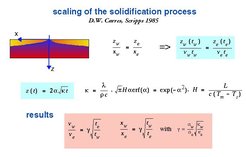Wax Tectonics
Pattern formation due to morphological instabilities has recently attracted considerable interest. Prominent examples are in directional solidification and fracture pattern. In this research program we are investigating a pattern forming system where solidification, fracture, and creep are important. Our experiments are concerned with geomorhological pattern formation occurring at the mid ocean ridges. In recent years our knowledge of the structure of the ocean floors have vastly increased. Satellite altimetry data of the ocean surface combined with the ship-bathymetry and paleomagnetism data led to an unprecedented knowledge of the oceanfloors. Recently it has been found that the structure of the mid ocean ridges is not only characterized by a rift that is interrupted and offsetted along the rift axis by transform faults and fault lines, but also that rotating micro plates of the size of a few hundred kilometers are found between the two large plates moving apart. One challenge in the investigation of the pattern-formation at the ocean floor is that the changes are very slow. The currently visible geomorphological structure has been created over the past 200 Ma. A good summary of the geophysical questions are given in the book by Keary and Vine. We also recommend this website for further info on this topic.
Our investigations are motivated by a need for an experimental system that allows the study of the dynamics of rift formation processes and its dependence on the material parameters of the solidifying crust. Following some initial work in the mid 70's we conduct an experiment in which molten wax is frozen at the surface by a flow of cold air. Then the solid crust is pulled apart with constant velocity and the formation of the rift between the two solid plates is studied.
Transformfaults and Microplates

Here you can find our results on Shell Callista 158. The animated paper (with movies) describes the amazing similarities of the wax morphologies and that of the earth: transform faults, fault zones and microplates.
Some movies of the dynamics are also available here:
transform faults and fault zones 1.08 MB
We have also done some checks for the scaling properties of the wax. Please click on the figures (from a talk) below:

Axial high at fast spreading and axial valley at slow speeds.

Agreement with relative values for the EPR and wax experiment.

Comparision of time and length scales between Earth Tectonics and Wax Tectonics.

Scaling of the thermal solidification process.

Comparision of the thermal solidification process Earth/Wax.
Pattern Formation in Lava Lakes

In this wax experiment we have found a morphological instabiltiy which is very similar to that found in lava lakes. The picture shows the zigzag rift formation observed in a lava lake. The width of the picture is approximately tens of meters. The rising newly formed rift is red. Clearly visible is the zigzag structure of the rift. In our experiment we found the same structure using Shell Wax 120.
More information on this experiment
This work was funded by the Alfred P. Sloan Foundation Foundation and the National Science Foundation through the Material Science Center at Cornell University.






